Ramie-field soil basic properties
Basic properties of soils from continuous ramie cropping fields in Yuanjiang, Xianning, Sichuan, and Jiangxi are shown in Table 1. Soil pH ranged from 5.33 to 6.67. Soil pH was similar in Xianning and Jiangxi, and in Yuanjiang and Sichuan. Urease activity and TN were the highest in Yuanjiang, with values of 0.62 mg/kg/h and 1.52 g/kg respectively, and the lowest in Sichuan, with values of 0.43 mg/kg/h and 0.76 g/kg respectively. The highest available P level of 38.61 mg/kg was recorded in Sichuan and the lowest of 24.82 mg/kg in Jiangxi. Available K was the highest in Yuanjiang, with 162.60 mg/kg, and the lowest in Jiangxi, with 92.94 mg/kg (Table 1). Statistical analysis showed that the soil PH values of Xianning, Jiangxi, Yuanjiang, and Sichuan were significantly different and that there were significant differences between the total N (TN) and available K in all four regions (Table 1).
Overall diversity of microbial communities in ramie fields in different regions
The overall diversity of microbial communities is shown in Table 2. In total, 385,225 raw reads and 360,544 clean reads were obtained for bacteria, and 456,224 raw reads and 444,898 clean reads were obtained for fungi. The clean bacterial reads included 43,095 reads for Yuanjiang, 64,954 for Xianning, 110,987 for Sichuan, and 141,508 for Jiangxi. The clean fungal reads included 80,267 reads for Yuanjiang, 200,601 for Xianning, 95,671 for Sichuan, and 68,359 for Jiangxi. The α-diversities indicated that the microbial diversity was high in all soil samples. The observed bacterial species ranged from 546 to 2,606. The number of bacterial species was the highest in Sichuan and the lowest in Jiangxi. Observed fungal species ranged from 82 to 466. The number of fungal species was the highest in Xianning and the lowest in Jiangxi.
Moreover, the calculated bacterial and fungal α-diversity species richness (chao1), Simpson, and Shannon indices were all different in the four regions. For bacteria, the results of ANOVA of the Shannon, Simpson, and Chao1 diversity indices showed significant differences, with Jiangxi showing significantly lower diversity than other regions (Table 2). Similarly, for fungi, these indices showed significant differences between the four regions of continuous ramie cropping (Table 2).
Soil microbial community composition in continuous cropping ramie fields in the different areas
Sequences that could not be classified into any known group were assigned as unclassified. The bacterial OTUs were assigned to 52 different phyla, 513 families, or 862 genera (Table S1). Five different phyla (Firmicutes, Proteobacteria, Acidobacteria, Other, and Gemmatimonadetes) out of the 52 total phylotypes were common to the four libraries, accounting for more than 85% of the total reads in each library (Fig. 1A, Table S1). Firmicutes was the most dominant phylum in all soil samples. In Jiangxi, this phylum accounted for 79.03% of all valid reads, which was more than that in other samples. Firmicutes accounted for 30.89%, 37.47%, and 29.46% of valid reads for Sichuan, Xianning, and Yuanjiang, respectively (P < 0.01, Table S2). Proteobacteria was the second dominant phylum. Compared with Firmicutes, Proteobacteria had a significantly lower abundance in Jiangxi (9.08%). In Xianning and Yuanjiang, Proteobacteria abundance was approximately 26% (P < 0.01, Table S2). Other bacteria, including Actinobacteria, Gemmatimonadetes, Bacteroidetes, Chloroflexi, Verrucomicrobia, WS3, Nitrospirae, Planctomycetes, TM7, WPS-2, AD3, Elusimicrobia, Cyanobacteria, Chlamydiae, Chlorobi, FCPU426, and TM6 were all the least abundant in Jiangxi.
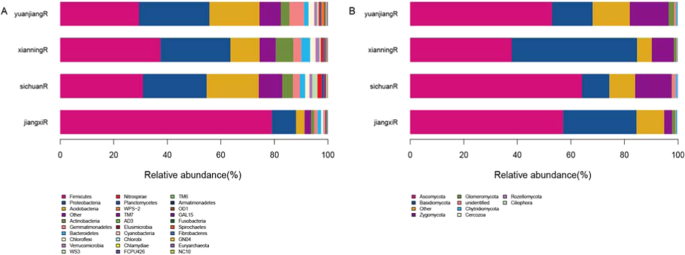
Relative abundance of the dominant bacterial (A) and fungal (B) taxa in four different area continuous cropping ramie soil samples at the phylum level. which were identified using the RDP classifier. Sequences not classified into any known group were designated as “other”.
We detected nine fungal phyla, with Ascomycota, Basidiomycota, and Zygomycota being the dominant (Fig. 1B). Ascomycota accounted for 37.96%–64.17% of all valid reads. Ascomycota members were the most abundant in Sichuan, with 64.17%, and the least abundant in Xianning, with 37.96%. Basidiomycota accounted for 10.25%, 15.23%, 27.44%, and 46.79% of the valid reads for Sichuan, Yuanjiang, Jiangxi, and Xianning, respectively (P < 0.05, Table S3). Zygomycota was the third dominant phylum in all samples, with an average relative abundance of 9.79% (P < 0.01, Table S3).
Differences in microbial community among continuous-cropping ramie fields in different areas
To explore differences in microbial communities among all soil samples, Venn diagrams were generated based on OTUs, using Mothur. In total, 93,326 bacterial OTUs were detected in all samples, among which 21,949, 12,260, 22,230, and 23,343 OTUs were detected specifically in samples from Sichuan, Jiangxi, Yuanjiang, and Xianning, respectively, and 829 were shared by all samples (Fig. 2A). Totally, 18,406 fungal OTUs were detected, of which 6,006, 3,587, 3,593, and 3,326 were detected only in samples from Sichuan, Jiangxi, Yuanjiang, and Xianning, respectively, and 256 were shared by all samples (Fig. 2B).
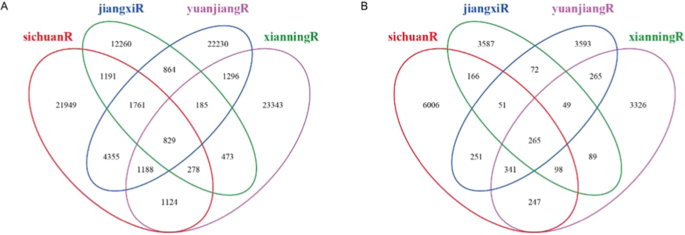
Venn diagram showing the number of unique bacterial (A) and fungal OTUs (B) detected in four different areas continuous cropping ramie soil samples.
The relative abundance of the 30 most dominant bacterial and fungal genera was visualised in heatmaps generated using custom R scripts. The bacteria Bacillus and Lactococcus presented a high relative abundance in all soil samples (Fig. 3A, P < 0.01, Table S2). Enterococcus was highly abundant in all samples, except in those from Xianning. Except for Bacillus, Lactococcus, Enterococcus, Alkaliphilus, and Camobacterium, other dominant genera had a low abundance (P < 0.01, Table S2). The fungi Mortierella, Candida, Cryptococcus, and Aureobasidium exhibited a high abundance in the four fields (Fig. 3B). Fusarium was highly abundant in Sichuan, Xianning, and Yuanjiang, but low in Jiangxi (P < 0.05, Table S3). Except for Mortierella, Candida, Cryptococcus, Aureobasidium, Guehomyces, Trichosporon, Malassezia, and Aspergillus, other genera presented a low abundance in Jiangxi. The heatmap showed that soil microbial composition was distinct in the different areas. The principal component analysis (PCA) was used to identify the community structure differences in different areas under continuous ramie cropping (Fig. 4). Two-dimensional plots of the coefficients of the first two principal components were generated to illustrate relationships among soil samples. As for bacteria, PC1 and PC2 contributed 13.974% and 12.993%, respectively (Fig. 4A). The PC1 value of Yuanjiang samples was similar to that of Sichuan samples, and Xianning samples had the highest PC1 value and Jiangxi samples had the lowest PC1 value. Although Jiangxi samples had the lowest PC1 value, the PC2 value was the highest. As for fungi, PC1 contributed 10.126% and PC2 contributed 8.25% (Fig. 4B). All soil samples had similar PC1 values. The PC2 values of the 12 samples were similar, but there were some differences; Xianning samples had the highest PC2 value and Jiangxi samples had the lowest PC2 value. In line with the heatmap results, the PCA results indicated that bacterial and fungal abundance differed among the four ramie-cropping areas.
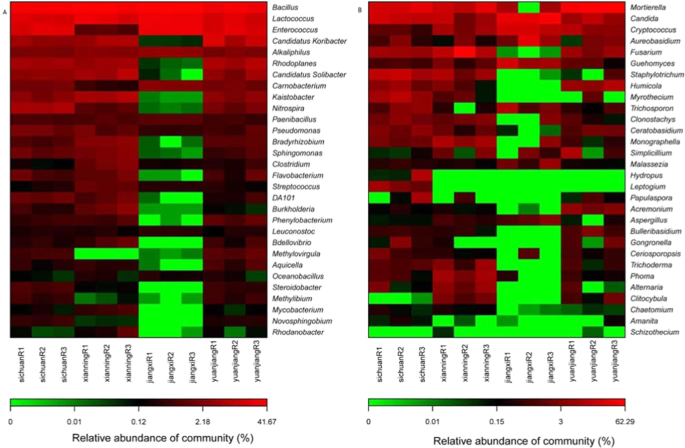
Heatmap analysis of bacterial (A) and fungi (B) based on the relative abundances of dominant genera from different areas continuous-cropping soil samples.
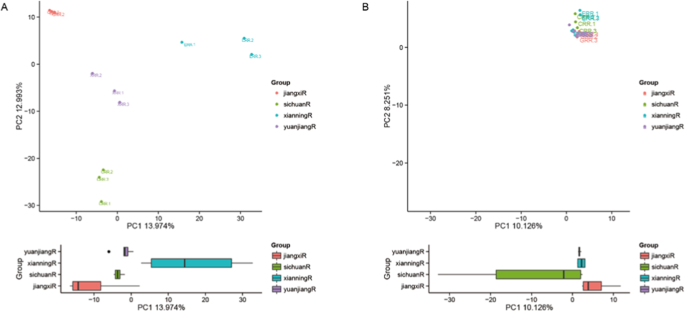
PCA of the OTUs detected major variations in the bacterial (A) and fungal (B) communities in four different area continuous cropping ramie soil samples.
Correlation between community structure and environmental factors
In all samples, the bacterial OTUs were significantly positively correlated with the performance of several environmental factors; however, for fungi, only total T was significantly correlated with fungal community abundance (Table 3). To further identify the major environmental variables controlling the soil microbial community structure, the RDA was performed (Fig. 5A). The RDA based on OTU reads and all studied environmental variables was carried out for the continuous cropping ramie fields in the different regions. Relationships between bacterial communities and soil properties are shown in Fig. 5A (axis 1 = 26.6%, axis 2 = 18.6%), and relationships between soil properties and fungal communities are shown in Fig. 5B (axis 1 = 12.2%, axis 2 = 11.3%). The length of the arrow in the RDA plot indicates the degree of correlation between the environmental factor and sample distribution. The analysis revealed that the urease activity and TN exhibited the most significant correlation with bacterial community composition in all samples, whereas soil T was the least correlated with bacterial community composition in all soil samples (Fig. 5A, Table 3). The effects of urease activity, TN, and soil T were in the order Jiangxi > Xianning > Yuanjiang > Sichuan, and those of available K and P, and pH were in the order Sichuan > Yuanjiang > Jiangxi > Xianning. The effects of TN and P were in the order Sichuan > Jiangxi > Xianning > Yuanjiang (Fig. 5B). The RDA results demonstrated that environmental factors significantly affect soil microbial community composition.
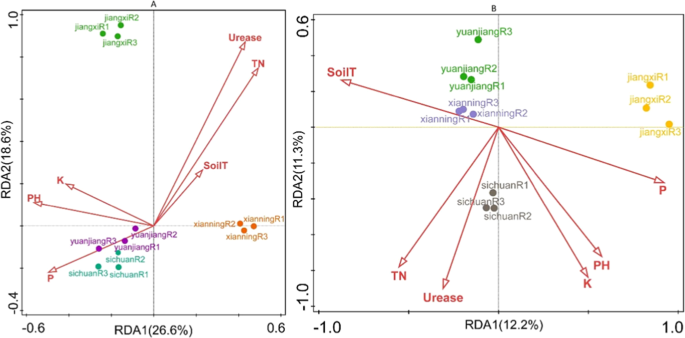
Redundancy analysis (RDA) based on bacterial (A) and fungal OUT (B) data with chemical parameters in four different area continuous cropping ramie soil.
Source: Ecology - nature.com



